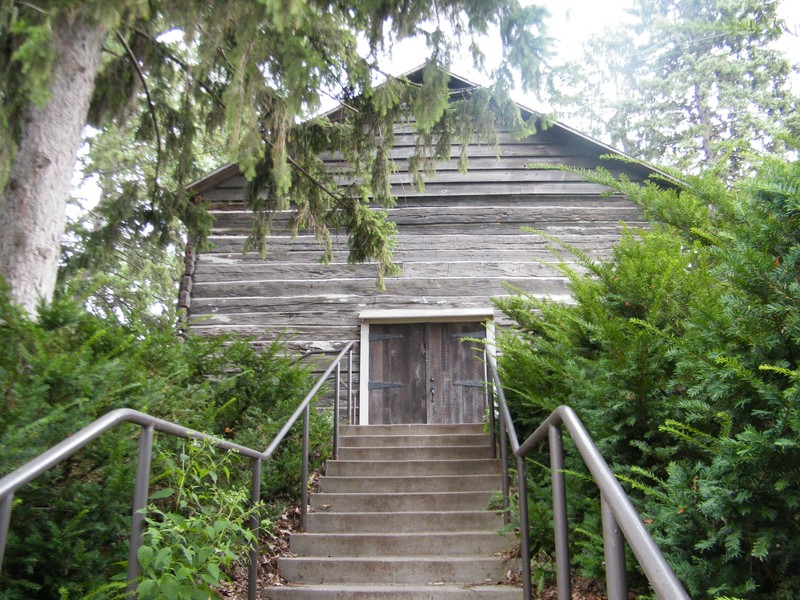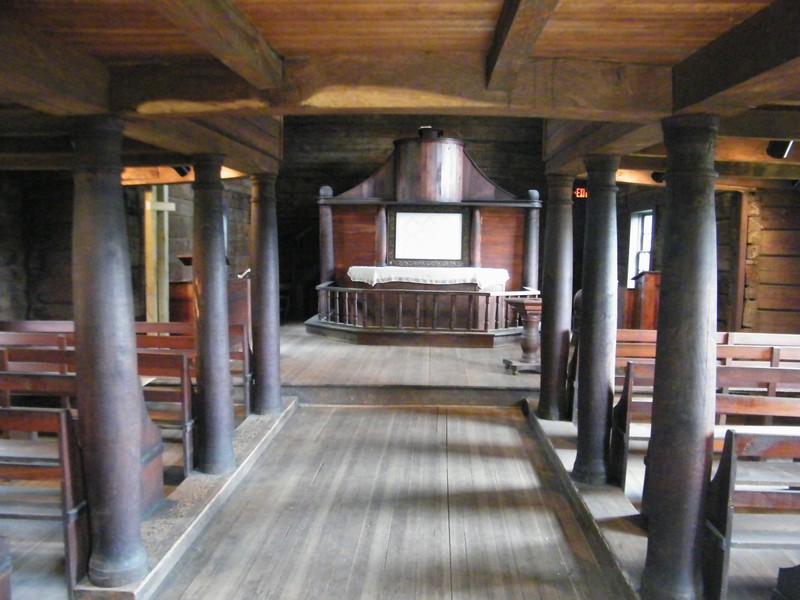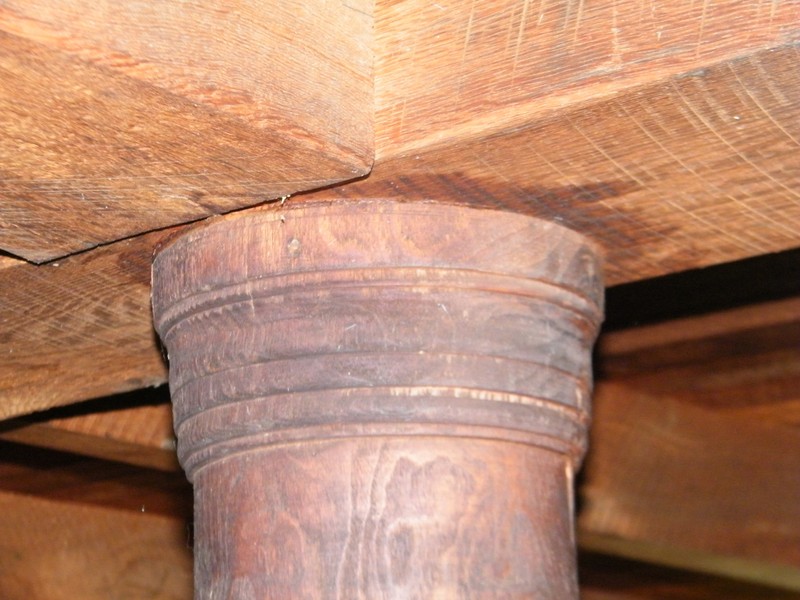Norway Lutheran "Old Muskego" Church
Introduction
Text-to-speech Audio
Norway Lutheran Church, also known as Old Muskego Church, was the first Norwegian church built in the United States. It was constructed in 1845 in Muskego, Wisconsin, to serve the growing Norwegian population there. It was used for its original purpose for 24 years before being replaced by a bigger church in 1870. The church was built on a hill called "Indian Hill", which had previously been a sacred site for the Potawatomi. After the new church was built, the original church was moved to a farm to be used as a barn. In 1904, Luther Theological Seminary bought it and had it transported to the current site on its campus. The church was reconstructed in its current location and restored by Charles L. Jacobson. The church's records are housed in the Seminary's archives and are available for research. The church was placed on the National Register of Historic Places in 1974.
Images
The Norway Lutheran Church, also known as Old Muskego Church, was built in 1845, making it the first Norwegian church built in the United States..

Entrance of the old Muskego log church, showing how finely the logs were joined together.

View of the altar from the congregation center aisle at the Old Muskego log church

Wood turning details on the walnut baluster at the Old Muskego log church

Backstory and Context
Text-to-speech Audio
As part of training Lutheran ministers, Gjermund Høyme, the head of the United Lutheran Church, envisioned having Lutheran theology students preach from a pioneer pulpit. That way they could experience a little of what a circuit pastor in the early days of the Norwegian American church did.
Høyme was dedicated to preserving the original preaching experience. Hearing from historians Rasmus Anderson and Hjalmar Rued Holand that the Old Muskego church was deteriorating, he began a fund-raising campaign to preserve the Old Muskego log church.
When the new church was built in 1870, the old log church was moved next door to the Jacobson farmstead. A generation later, Hans Jacobson was using it as shelter for his pigs. Jacobson sold it to the United Lutheran Church for $100. With the help of other Jacobson family members, they numbered the ends of the logs and dismantled the pioneer log church. It was shipped by railroad car to St. Paul, Minnesota to the grounds of Luther Seminary. The Jacobsons’ then helped reconstruct the log church.
Ministers throughout the Midwest have shared how meaningful it was for them, as Luther Seminary students, to attend services and preach in the Old Muskego Log Church on campus. Some people feel that the log church should never have left Muskego-Norway, but ongoing preservation of the church is costly. It is fortunate that the college maintains this unique historic structure.
The Old Muskego log church is on the campus of Luther Seminary, behind Gullixson Hall, 2375 Como Avenue, St. Paul, Minnesota. Borrow a key at the second-floor library desk to see the inside of the church. Terry Martin, author of the book New Masters of Woodworking wrote that:
“. . .(I) stumbled upon one of the true woodturning treasures in the United States when I visited here. It was clearly an attempt to elevate their place of worship above the commonplace.”[1]
The altar and pulpit are made of walnut. The altar cloth was designed by Norwegian church vestment expert Helen Engelstad using the needlework style of the time.
Paul Daniels, Luther Seminary archivist, explained that the Old Muskego Log Church was meant to be a temporary structure. When the church was moved to Luther Seminary, it was placed on a hill, overlooking its surroundings, similar to the way the building originally overlooked the Muskego-Norway countryside.
In the twenty-five years that it served as a place of worship, the old Muskego log church saw thousands of immigrants bow their heads to pray. For many, it was the first church they had been in since arriving from the old country. They knelt and gave thanks that they had survived their journey. They prayed for help to find fruitful land and build a good life in America. Hundreds grieved in the same log church during the cholera epidemics and other illness and accidents which took their loved ones from them. Much joy, pain and sense of community has been experienced in the walls of this church.
In the First Chapter of Norwegian Immigration Rasmus Anderson wrote about a letter he received from H.J. Ellertsen, describing the church building:
“It was built of oak logs hewed on both sides, six inches thick, and matched after the Norwegian fashion of building houses. On the inside the logs were dressed perfectly smooth and then fitted so close together that no mortar was used between them. Double doors in the front were made of black walnut. The pulpit was also made of walnut.
“Galleries were built across the front and along both sides of the church. These galleries were supported by six lathe-turned solid walnut columns. The erection of the church (started) in spring 1844 and the dedication took place March 13, 1845. It is undoubtedly the first Norwegian church built in America.”[2]
As the Muskego congregation became wealthier, they built a new brick church on Indian Hill. At the same time, they were building frame and clapboard homes to replace their modest log cabins. It was a sure sign of progress.
In 1870, the old log church was auctioned off, dismantled and rebuilt on a local farm. Rasmus Anderson and Gjermund Hoyme discussed rescuing the church, which was being used as a farm outbuilding and bringing it to Luther Seminary. There it could be used as a chapel, so theology students could experience how pioneering Norwegian immigrants worshiped. Hjalmar Rued Holand was disturbed to see the old Muskego log church used as a grisehus (pig sty) and urged that it be saved.
The United Lutheran Church synod negotiated buying the building from Hans Jacobson for $100. They quickly signed the contract after Jacobson said that the Norwegian Synod gave him an offer for double the price. The United Lutheran Church was able to acquire the building, because of the relationship their local minister, Gerhard Rasmussen, had with the Jacobson family who owned it. At the time, locals wanted to keep the church at Muskego. In retrospect, it was fortunate that the church went to Luther Seminary, because it has taken significant resources to maintain the building over the years.
The cost to move the building to St. Paul and rebuild it was $2,000 ($65,000 in 2024 money). Sons of Peder Jacobson, one of the original church builders, numbered all the logs so the log church could be properly reassembled.
In the National Registry of Historical Places application, Minnesota historic sites survey specialist John Hackett wrote:
“In 1904, Muskego church was purchased, dismantled and removed to be reconstructed at the building’s present site. The exterior walls were adzed, and hand planed . . . The massive logs are coped and scribed with interlocking ends shaped by an axe. The fit of the hewn logs is so tight that only the interlocking ends of the logs have been chinked with clay . . . The church had segregated seating, with men on the right and women on the left. The balcony was also segregated. The pews are not original but of this uncomfortable type.” [3]
Woodworking expert Terry Martin wrote:
“The size of the columns is impressive – at least seven feet tall and quite thick. They must have been hard to mount on a lathe. When I looked more closely . . . the tool marks were still quite evident and there was a lot of deep tearout on the detail work. (I have) the deepest respect for the craftsmen who worked so hard to produce this work . . .
“Halvor Lohner, a house builder from Telemark, took a leading part (in building the church) and Peder Jacobson . . . was the one who by use of a lathe turned the pillars inside the church. Ole Spellum is said to have turned the balusters of the small pillars of the altar ring . . . Jacobson probably had to forge his own tools . . . The lathe used to turn these columns must have been very large. How was it driven? Large logs like this are very heavy . . . It must have taken a lot of power to start them turning and to maintain any kind of speed.
“When I sat quietly in this old building and thought about those turners, I was quite moved . . . I have to ask myself if I could produce such work under those conditions and I am sure I could not . . . If I was impressed when I walked through the door, I can imagine how it must have seemed to the farmers of the region when they first saw it.” [4]
Women of the congregation helped build the church alongside the men. Hjalmar Rued Holand wrote that when he visited the Old Muskego Church in 1897, he learned that Kari Hogenson carried wooden shingles up the ladder to her husband Ole, who shingled the church's roof [5] Other women would have labored alongside their husbands, or in splitting wooden slabs to make shingles, or in their kitchens supplying nutrition to the building bee.
Sources
[1] Martin, Terry. Muskego Chapel : A Treasure Trove of American Folk Turning, American Woodturner magazine, Summer 2009, pages 50, 52.
[2] Anderson, Rasmus. The First Chapter of Norwegian Immigration (1831-1840) its Causes and Results (Madison WI, 1895), page 419-420
[3] Hackett, John. National Register of Historical Places Inventory – Nomination Form: Muskego Church, paper 1974. (Luther Seminary archives, St. Paul, Minnesota) page 2
[4] Martin, pages 50-52
[5] Holand, Hjalmar Rued, Rosholt, Malcolm, Nelson Gourley, Deb, et. al. History of the Norwegian settlements : a translated and expanded version of the 1908 De norske settlementers historie and the 1930 Den siste, (Waukon IA, 2006), page 51
Hackett, John. "Norway Lutheran Church." May 12, 1975. National Park Service - National Register of Historic Places Nomination Form. https://npgallery.nps.gov/GetAsset/6c8ea06f-1dcf-4fe6-a953-71bb1e1cf1a3.
"Old Muskego." Luther Seminary. Accessed April 5, 2017. https://www.luthersem.edu/archives/muskego.aspx.
Luther Seminary Archives. Muskego archival files. Includes: Muskego Altar Cloth, Waterford Post newspaper clippings
Nelson, E. Clifford. Data on Restoration and Moving of Muskego Church, paper, 1966. (Luther Seminary Archives, St. Paul, Minnesota)
Sihler, E.W. The Muskego Church: Notes and Articles about its removal from Wisconsin to the Seminary, St. Paul, Minnesota, paper, 1965 (Luther Seminary Archives, St. Paul, Minnesota)
Photo: Wikimedia Commons
Wikipedia
Palecek, Mike
Palecek, Mike
